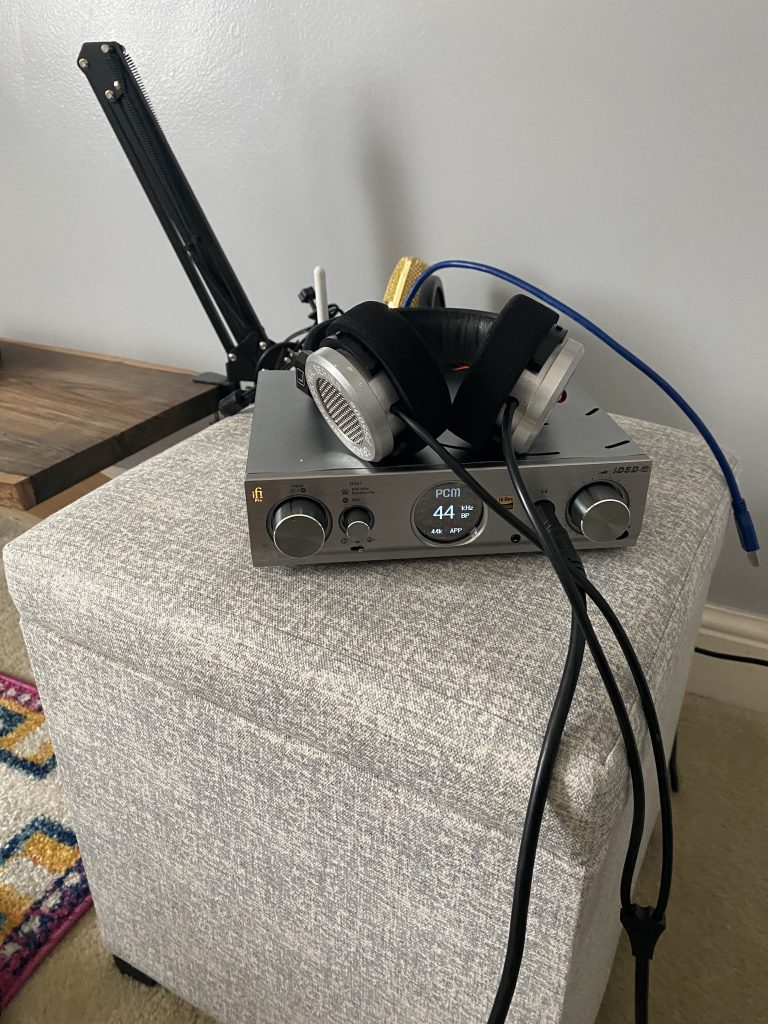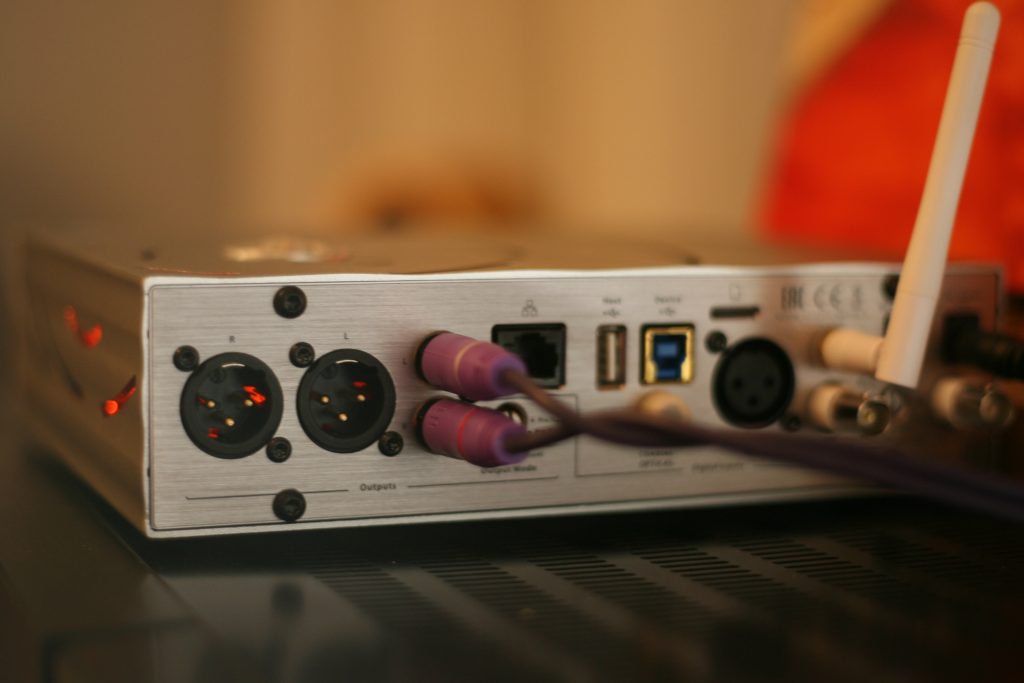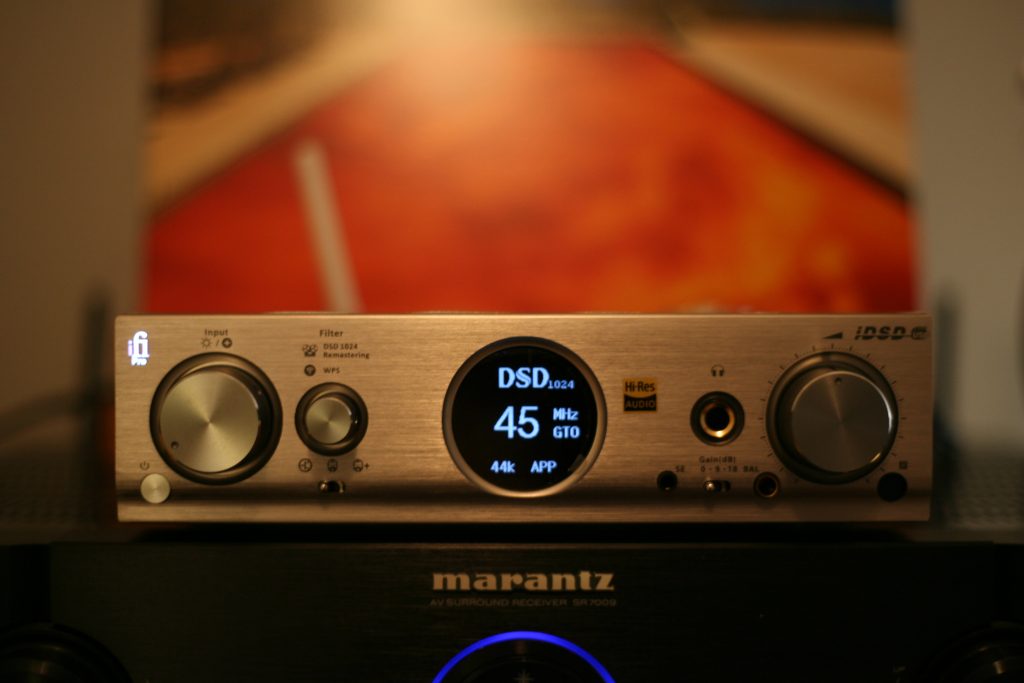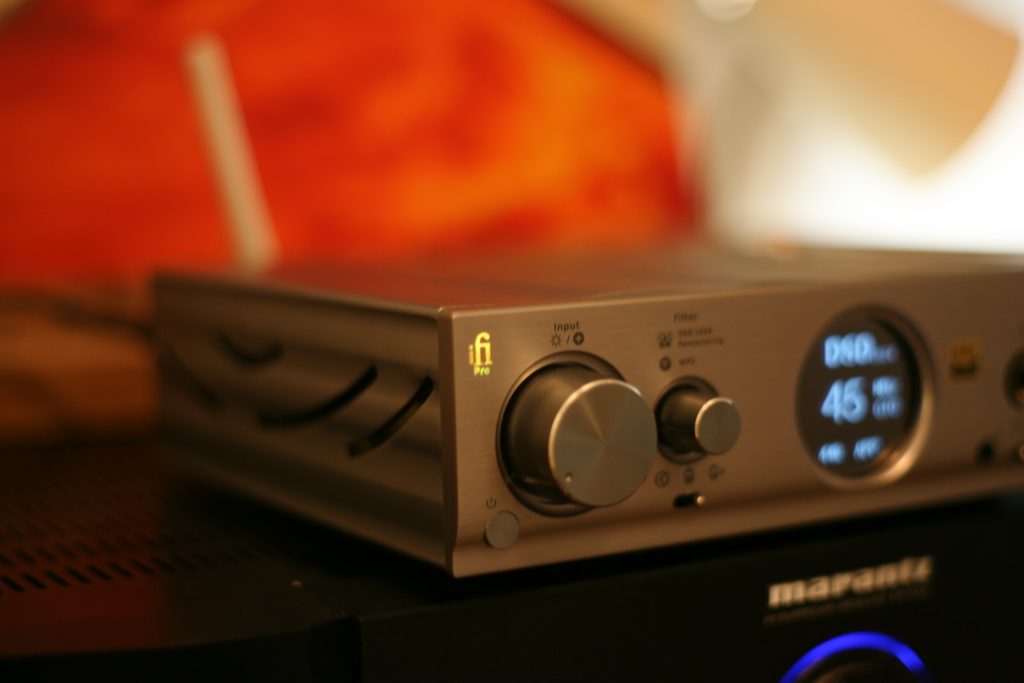We have another product from iFi for this review and it is the Pro iDSD. We have been dipping into the world of external dacs recently while also getting into the headphone world. They seem to really go hand in hand so that would make sense. The Pro iDSD is more than a headphone amp or dac. It is a high res streamer, headphone amp, and external dac all rolled into one. Even more so it is an option and feature-packed unit on top of all that. All of this comes packed into a [relatively] small beautiful metal package. This is not a cheap unit, at retail of around $2500.00, but with its features and sound it very well may be a great value, so let’s get into that.

Pro iDSD ins and outs
Where do we even start here, there are so many listening options on this unit. I think we will start with connectivity. On the front you have your headphone outputs, on ours, we have 3. There is a 6.35mm output, 3.5mm, and a balanced 4.4mm output option. They have you pretty covered here.
Around the back, there are several more options to connect your various devices. We are going to go ahead and do a list here, it should make it a little easier to see what you have to work with.
Outputs:
- Balanced XLR
- RCA
that’s it for output, and very much by design. Some Amp/Dac?streamers will have digital outputs in the event that you are using some other dac to handle dac duties. iFi has put a lot of work in both in hardware and firmware into the Pro iDSD to make it the best dac that they could. We will get into that later though.
Inputs:
- XLR
- USB (external drive or flash storage)
- USB B 3.0 (connect to computer USB)
- Micro SD
- Wifi
- Ethernet
- Coax
- BNC with Clock Sync output
Just like there are no digital outputs there are no analog inputs, for the very reason mentioned above.

Settings options
The only thing more numerous than your connectivity options is your listening options. There are 45 different combinations of the listening options available to you to explore through not including 3 different gain options for the headphone amp. Because there are 45 different combos we are not going to get into what each one sounds like but rather talk about what each does and I will tell you which combo I personally liked best.
We are going to talk about them in the three groups that they are apart of. First we have our tube and solid state options, next there is the DSD sampling rate, and third are the filters available.
The Output stage has three options to select from. You can Choose Solid State, Tube, or Tube+. The Solid State option will send your signal through a Class A J-Fet setup. The Tube option turns off the solid state circuit and sends the signal through two GE5670 tubes and the Tube+ option will reduce the negative feedback, allowing for more of the tubes’ natural distortion to come through.
Next you can select your DSD upconvertor options, here again, you have three to choose from. Normal, DSD512, and DSD1024. All audio coming in (other than DSD512) will be upconverted to your selection in this section. I recommend playing around with it as well as the options to see what you like best.
Last we have the filtering options. Here we have 5, and the best way to describe them is to use iFi’s words to tell you what they intend these to be like.
- ‘Bit-Perfect’ – No digital filtering, one tap1
- ‘Bit-Perfect+’ – No digital filtering, one tap, SINC roll-off @ HF is corrected
- ‘GTO’ – Gibbs Transient Optimised
- ‘Apodising’ – Modest filtering, no pre-ringing, modest post ringing, 128 taps
- ‘Transient Aligned’ – Max filtering, max pre-ringing, maximum post-ringing, 16,384
taps
some additional notes about them below:
1)Bit-Perfect is equivalent to what has been called “non-oversampling”, “zero-oversampling”, “filterless” etc. This offers the best impulse response but loses high frequency extension. There is no pre- or post-ringing with an
impulse and ultrasonic images are minimally suppressed. This filter produces a sound that is highly musical with
precise but sometimes a little limited imaging and seems to slightly lack detail and air.
2) Bit-Perfect+ is AMR’s take on “non-oversampling” and uses a tailored analogue filter to correct the system
response so detail and air are restored. Until now this operation was exclusive to AMR products, the Pro iDSD is
the first iFi product to include it. There is no pre- or post-ringing with an impulse but a slight alteration of the
impulse shape and ultrasonic images are minimally suppressed. It produces a sound that is natural, organic and
with a precise, focused sound stage and the correct HF detail and air.
3) Apodising – Apodising Filters are relatively new and based on the work of acoustic researcher Peter Craven
published in 2004 and championed by Bob Stewart (of Meridian & MQA) and aim to correct some of impulse
distortion during recording. This filter also avoids pre-ringing but introduces more impulse distortion in an attempt to “override” the impulse response of the recoding system and suppresses all but the first ultrasonic image strongly. The sound produced is fairly natural, with a slightly de-focused and enlarged sound stage and correct HF detail and air.
4) Transient Aligned – This filter is based on the theory that if an infinite number of taps filter was used the response of the system would conform to a theoretical, mathematical ideal response. This filter maximizes pre- and postringing on impulses – in fact the whole time domain response of this filter for CD-Audio takes a total of 0.37 seconds. Suppression of ultrasonic images is maximal. The sound produced is distinct, with an enlarged sound stage and very smooth high frequencies.

iFi Pro iDSD Sound
The sound is a little more complicated to discuss than in some of my other reviews. There are so many options and inputs and outputs so we will break it into two sections, one for headphone use and one for stereo use.
To feel out the headphone amp side of the Pro iDSD I used two headphones, my Audio-Technica ATH-M40x and Grado PS500e. I didn’t really think the M40x was really on par with the iDSD but I wanted a baseline I was super familiar with as they are my daily use headphones. To get a good feel for the Grado PS500e I spent a couple of weeks listening to them straight out of my MacBook Pro as well as Windows machine for about 7-8 hours a day during those two weeks. I played with all of the setting options and with the PS500e headphones I liked the combo of Tube, DSD1024 and BitPerfect. I thought this gave them the clearest and full-bodied sound. When I tried the Solid State with the PS500e they seemed a bit thinner, the low end didn’t seem like it was coming to the party, with my M40x this was not really the case though. That is someone expected of open back reference cans compared to closed back. The M40x has plenty of low end and warmth to begin with so with those the Solid State Option sounded great.
I want to be clear about one thing though if you own ATH-M40x headphones I do not recommend the Pro iDSD. It is just overkill, yes they sounded better than straight out of the computer but there is a limit to how good they can get. If you want to look into dacs and amps for entry level headphones check out the Zen from iFi. The Zen is plenty for something like a pair of M40x or M50x. Now if you plan to upgrade your headphones but want to get a dac/amp first then that may be a different story. I reviewed the Zen with my M40x and they sounded brilliant, they did not sound all that much better with the Pro iDSD, nearly at the limit of how good they could be with the Zen.
The Grado PS500e is a much different story. There is a much higher limit to how good they can sound. As I mentioned in my review of just them, it is a disservice to listen to them right out of your computer or phones headphone jack. Granted they are not hard to drive so you don’t need all the amplification available to you with the Pro iDSD but the dac is where you benefit with PS500e headphones. If you use the notoriously power hungry HD600 you may find you need to up the gain, luckily the Pro iDSD has you covered there. On their own i almost did not care for the PS500e, they just did not as Shania Twain once said “impress me much”. Don’t get me wrong they sound very nice out of the box and I recommend trying them out if you haven’t before but they just seemed like they were missing something, it was detail, that they have plenty of. They are not lacking in sound stage, they are great open back cans. It seemed like they didn’t have soul, they were almost like a fillet, great on its own but with a little seasoning, it really comes to life. The Pro iDSD and it’s different flavors were just what the PS500e needed. I loved them with the Tube Setting, I truly enjoyed listening to them for hours on end. They had warmth, even more detail, and just an excitement to them they lacked on their own. If you own Grado PS500e and you are not running any type of dac, you need to do yourself a favor and get one.

The other way I checked out the Pro iDSD was in my 2 channel system. I set it up on my wifi and streamed to it from my Macbook. Normally I would plug my Mac into an analog input on my Marantz SR7009 and control streaming from my phone through Spotify. You can also play other streaming options and the Pro iDSD supports MQA if you have a service offering that. I sometimes get a bit of flac for using Spotify as an audiophile (see what I did there) but after 12 years of use and the massive playlists I have I have a hard time changing. I also like that I am extremely familiar with how music sounds having listened to some of these tracks on the same service for 10-12 years. There is something to be said for having a good reference point no matter where it is on the spectrum. I can tell you that not using my MacBook’s built in dac and instead, using the Pro iDSD to handle that offers a significant quality upgrade even in Spotify Premium. When I have it set up with my 2 channel system I really enjoy the GTO filter the most. Much like the Grados with the Tube Setting, the GTO setting seemed to give my setup the most soul. It is difficult to describe, it cut some of the brightness out of my Martin Logan LX16 speakers, just making them more pleasing to the ear. The filters are not massive changes, they are more like tuning tweeks, just helping you dial in that last bit of your version of perfect sound.
Tech info
We have to talk about how this whole thing works and why it is as good as it is. As I mentioned earlier iFi put a lot of thought into making the Pro iDSD. There is a lot of tech packed into this relatively small package. There are two separate amp circuits, which are even split further in half to give you the balanced output option. For the dac end of things there are 4 DSD and DXD Burr-Brown Dac chips. Processing power is supplied by an XMOS 16 core processor. The Firmware is made in house by iFi to make all this awesome tech work together in a way we as audiophiles can use.

Conclusion:
As always let’s discuss who this is for. It is certainly not ideal for the casual headphone listener, it just does not make a lot of sense or even the casual home stereo listener. Granted just about every type of listener can benefit from a better dac, it doesn’t always make sense to spend your money on one if the rest of your listening equipment isn’t up to the level of the iFi Pro iDSD. I do not do the majority of my critical listening on headphones as usually while I have headphones on I am distracted by something I am working on, so for this review, I borrowed as mentioned the Grado PS500e headphone from The Cable Co. as I didn’t think my ATH-M40x were really worthy of this dac/amp. The truth is, this was confirmed while listening to it with my M40x headphones, they just did not let the Pro iDSD shine. The PS500e on the other hand was a different story. If you have high end revealing headphones and your are currently using a more entry level dac and are considering upgrading, I suggest you look into the Pro iDSD and see if it is something you can benefit from. There is another potential customer for the Pro iDSD, someone who wants to improve the dac in their 2 channel stereo setup. Normally digital to analog duties are done inside my Marantz SR7009, while it does a good job, it has a lot of other tasks to handle so the dac built in is not top notch. Generally speaking, built in dacs are good enough, that is for average listening, but they can be improved upon in almost all cases. granted there are some top tier preamps out there that have amazing dacs, but we are talking upper echelon products with pricing to match. If you have a more middle of the road preamp from say Marantz you will likely see improvement in seeking external DA conversion. An additional person who may find this product interesting is the vintage enthusiast. Digital inputs are just simply not on vintage gear, it didn’t exist yet in many cases. Laserdisc was read by a laser but it was still an analog source, we didn’t see digital CDs until 1982, so if you are into 70’s receivers but would like to be able to listen to digital sources you may want to check out the Pro iDSD as well. To wrap things up I unfortunately or fortunately, do not have anything to compare the Pro iDSD to, I wish I did as I think it helps convey sound to others. It is really in a class all its own, I don’t know any other dac out there that offers the flexibility in tuning your sound as well as the sound quality that this has, especially at its price of 2500.
Disclaimer:
iFi Audio provided Hifi Chicken with the Pro iDSD for review, this review was not paid for in full or part by iFi Audio. The Cable Co. provided Hifi Chicken with the Grado PS500e to use in conjunction and will be a valued partner for Hifi Chicken, Grado nor The Cable Co. did not pay in full or part for this review. We do want to thank both iFi Audio and The Cable Co. for working with us to help bring you great reviews.
For more information about iFi Audio or The Cable Co. please follow the links below
https://ifi-audio.com/
https://www.thecableco.com/








